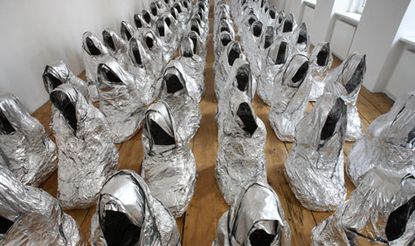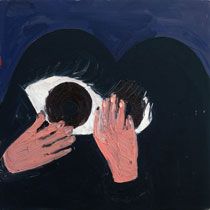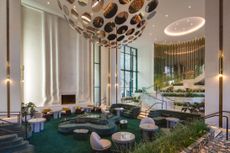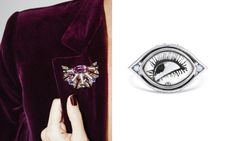New Art from the Middle East, Saatchi Gallery

Despite featuring mannequins of Teherani prostitutes, semi-naked men and all manner of jabs at repressive statehood and religion, Charles Saatchi's latest show, Unveiled: New Art from the Middle East, has, to date (it only opened 30 January), been remarkably uncontroversial. So far, no uproarious demos outside the Chelsea gallery, no mullahs up in arms, despite the boundary-pushing content of much of the show.

See more of the art works in the show
Featuring the work of 19 artists from Tunisia to Iraq, Algeria to Syria, highlights include a room filled with tin foil models of 251 Muslim women at prayer by Franco-Algerian artist Kader Attia and Tehran-based artist Shadi Gahdirian's photos of women in habibs, whose faces have been replaced with mundane domestic objects such as cheese graters, irons and sieves.
What's also surprising is that, while some of the artists live and work outside their countries of birth, many are producing these contentious and daring works at home. Take Iranian Ramin Haerizadah who lives in Tehran and appears semi naked and hairy, dressed as a woman in a series of pictures entitled 'Men of Allah', in which he mocks the macho views of the bearded clerics who preach female oppression.
Others, such as Iraqi artist Halim Al-Karim endured great hardship at home and fled to America. During the Gulf War, Al-Karim hid in a hole in the ground in the desert for three years in order to avoid military service. Not surprisingly, his work criticizes political oppression, particularly Saddam's regime, and instead of goading us, as so many western contemporary artists do, he makes you pause for thought.
Political and social conditions in their homelands give all of the artists in this show much to draw upon; the predictable art world themes of sex, celebrity and consumerism, more sex, more celebrity, more consumerism, are refreshingly absent.
Instead, Lebanese artist Marwam Rechmaoui has built a rubber floor map of Beirut as it is today, with all its divisions, and created a replica of the apartment block in Beirut in which he lived until it was evacuated during the conflict with Isreal in 2006. Palestinian artist Wafa Hourani, who works in Ramallah, visualizes the Palestinian refugee camp of the future. Consisting of scale models of decrepit settlements under Israeli surveillance it is entitled Qalandia, after the main checkpoint through the West Bank Security Fence, and dated 2067. Each model acts as a miniature light box with filmstrips in the windows, showing glimpses of life within. Like many of the pieces in the show, it has a clear and powerful message, and, in light of recent Israeli actions in Palestine, is perhaps a premonition.
Wallpaper* Newsletter
Receive our daily digest of inspiration, escapism and design stories from around the world direct to your inbox.
ADDRESS
Duke of York's HQ
King's Road
London SW3 4SQ
Harriet Lloyd-Smith was the Arts Editor of Wallpaper*, responsible for the art pages across digital and print, including profiles, exhibition reviews, and contemporary art collaborations. She started at Wallpaper* in 2017 and has written for leading contemporary art publications, auction houses and arts charities, and lectured on review writing and art journalism. When she’s not writing about art, she’s making her own.
-
 Wallpaper* checks in at the refreshed W Hollywood: ‘more polish and less party’
Wallpaper* checks in at the refreshed W Hollywood: ‘more polish and less party’The W Hollywood introduces a top-to-bottom reimagining by the Rockwell Group, capturing the genuine warmth and spirit of Southern California
By Carole Dixon Published
-
 Book a table at Row on 5 in London for the dinner party of dreams
Book a table at Row on 5 in London for the dinner party of dreamsRow on 5, the first restaurant ever to open on Savile Row, emerges as a perfectly tailored fit for fans of fan dining
By Ben McCormack Published
-
 How a bijou jewellery salon in Monaco set the jewellery trends for 2025
How a bijou jewellery salon in Monaco set the jewellery trends for 2025Inside the inaugural edition of Joya, where jewellery is celebrated as miniature works of art
By Jean Grogan Published